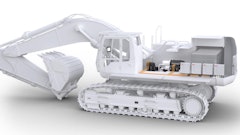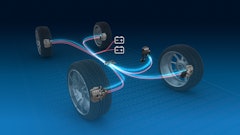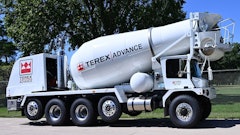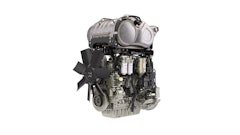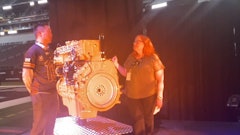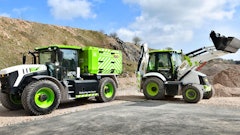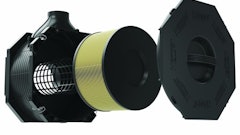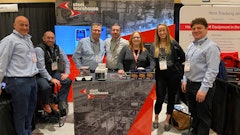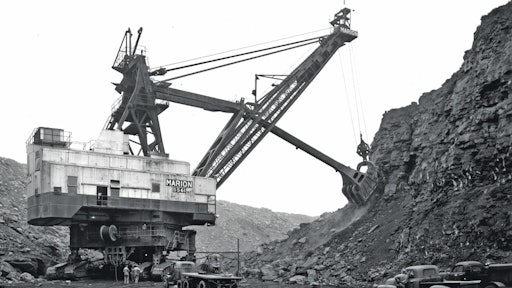
To meet demand for greater productivity in overburden removal, Bucyrus-Erie developed a counterbalanced dipper hoist for stripping shovels in 1930. It connected the dipper hoist drum to a vertically mobile counterweight, thereby increasing payload capacity and energy efficiency. Marion Power Shovel responded in 1932 with its own rack-and-pinion counterbalance system. But Marion revolutionized stripping shovel design in 1940 when it patented the knee-action crowd.
On conventional shovels, the dipper handle is mounted to a pivot midway up the boom, where the shipper shaft crowds the bucket into the bank and hauls it back. With knee-action crowd, the dipper is raised and lowered from the boom tip as with a conventional shovel; but the dipper handle passes freely through the boom to meet one end of a connecting arm at the top of a moveable stiffleg.
The stiffleg is mounted to the frame of the upper works, inside the boom base, and it pivots back and forth above the plane of the boom, moving with the dipper handle as it is crowded forward and backhauled. The action at the joint atop the stiffleg resembles the bending of a knee; the apparatus was also called a “grasshopper leg” front end, because of how the dipper handle and stiffleg appear to fold like a grasshopper’s leg.
The connecting arm’s other end passes through the crowd and backhaul machinery. Located in the gantry atop the shovel house, this machinery uses cables or a rack-and-pinion mechanism to move the connecting arm forward and back, thereby creating the crowd and backhaul motion of the dipper.
This design, which made possible the largest shovel ever built, had several benefits. Digging power increased at the point where such power was most needed as the bucket was crowded into the bank. The bucket moved horizontally into the cut, providing a long radius for cleanup work and keeping the bucket teeth from disturbing the underlying minerals during its arc of travel. Swing efficiency was increased by placing the crowd machinery closer to the machine’s center of rotation. A lighter boom enabled greater bucket capacity and further enhanced swing efficiency, and torsional and bending stresses were eliminated from the boom by connecting the dipper handle to the stiffleg instead of the boom.
The Historical Construction Equipment Assn. (HCEA) is a 501(c)3 non-profit organization dedicated to preserving the history of the construction, dredging and surface mining equipment industries. With over 4,300 members in 25 countries, activities include operation of National Construction Equipment Museum and archives in Bowling Green, OH; publication of a quarterly magazine, Equipment Echoes; and hosting an annual working exhibition of restored construction equipment.
Individual memberships are $30.00 US within the U.S. and Canada, and $40.00 US elsewhere. We seek to develop relationships in the equipment manufacturing industry, and we offer a college scholarship for engineering students. Information is available at www.hcea.net, by calling 419-352-5616 or e-mailing [email protected].






